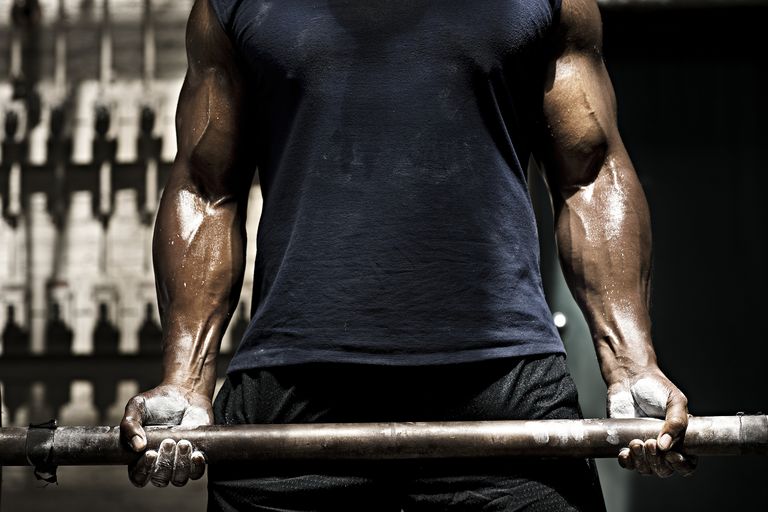
Guys work for hours in the weight room to build healthier, fitter bodies, but let’s be real for a minute: One of the biggest reasons dudes hit the gym is to make themselves look good.
If you’re just as focused on your appearance as building strength and mass — and there’s nothing wrong with that — there’s no better place to start than your biceps. The muscles are composed of a long and short head, which team up to handle movements like flexing, and curling, that make your arms pop.
The muscles take up a ton of prime real estate on the front of your arm, and they’re probably the easiest part of your body to show off no matter the situation or who you’re trying to impress. Whether you rock a dress shirt or a tank top, a strong set of guns are sure to make waves.
That’s why we created this list of 25 awesome ways to work your biceps. Some of these are classics; some are new. Some are a grind; some are fun. Some hit the long head of the muscle; some focus on the short head.
Pick the ones you like (and maybe some that you don’t), and use them to pump up your arms — and fill out your sleeves.
1. STANDING BARBELL CURL
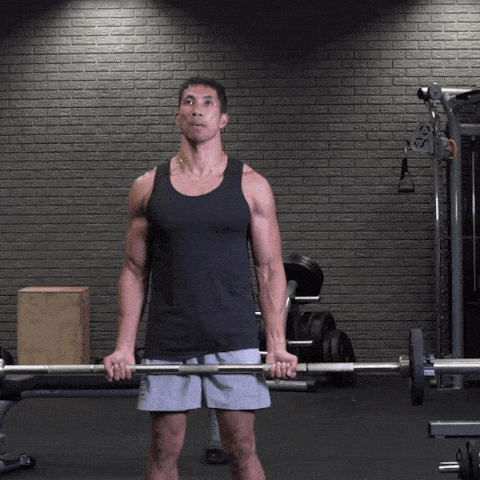
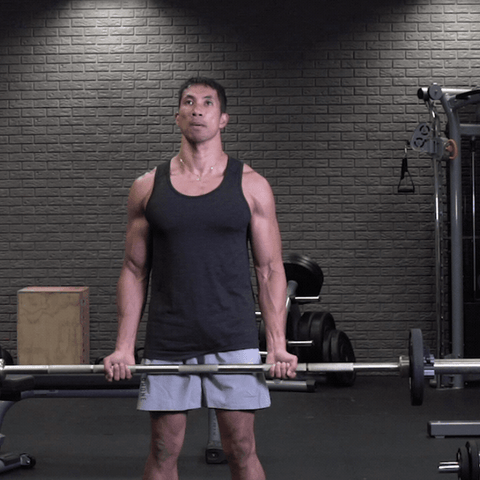
Men's Health
This is as basic as it gets. You’ve probably heard serious lifters carrying on about oblivious meatheads taking up space in squat racks to do bicep curls, so be mindful when and where you load up a barbell — but that shouldn’t be an excuse to skip out on the move entirely. Barbells allow you to work both arms simultaneously and evenly, and the position of your grip can allow you to home in on different parts of the muscle.
How to do it: Grab the barbell with an underhand grip, with your your hands positioned about as wide as your hips. To emphasize the inner portion of the bicep, take a wider grip; to target the outer part of the muscle, bring your hands closer together. Start holding the bar at hip height, then squeeze your core and contract your biceps to curl the bar up to shoulder height. Squeeze your biceps at the top of the movement, then slowly lower the weight back to the starting position, controlling the weight through the eccentric movement. Make sure to keep your feet solidly planted throughout the exercise, and don’t use your hips to lift the weight.
2. STANDING RESISTANCE BAND HAMMER CURL


Men's Health
Leave the weights on the rack and give resistance bands a shot to really reap some bicep gains. The bands allow you to work through the full range of the motion by offering resistance (get it?) through the eccentric (lowering) part of the exercise, along with the concentric (curl) lift. The hammer grip, meanwhile, shifts the focus of the work to the brachialis, a lower muscle that can really make your arms look thick.
How to do it: Step on the center of a resistance band, gripping one end of the implement in each hand. Hold the band with your palms parallel to each other. Curl your hands toward your shoulders, maintaining the position of your palms. Squeeze your biceps at the top of the movement before lowering your hands back down to your sides, maintaining constant tension on the band. Keep your elbows stable and in position at your sides throughout the movement.
3. STANDING DUMBBELL CURL
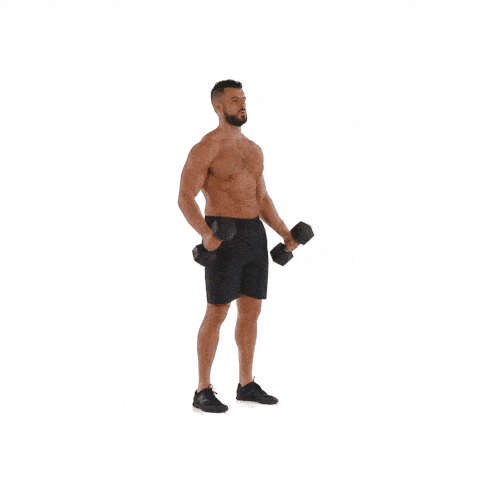

Men's Health
In a biceps-focused list like this, you can’t leave out the classic dumbbell curl. So we didn’t.
But we would ask that you use a weight that makes sense: If you’re swaying back wildly and contorting your body—especially excessively arching your lower back—to lift the load, you should probably get a lighter pair of dumbbells.
How to do it: Grab a pair of dumbbells and let them hang at arm’s length next to your sides. Turn your arms so your palms face forward. Without moving your upper arms, bend your elbows and curl the dumbbells as close to your shoulders as you can. Pause, then slowly lower the weight back to the starting position. Each time you return to the starting position, completely straighten your arms.
4. OFFSET-GRIP DUMBBELL CURL
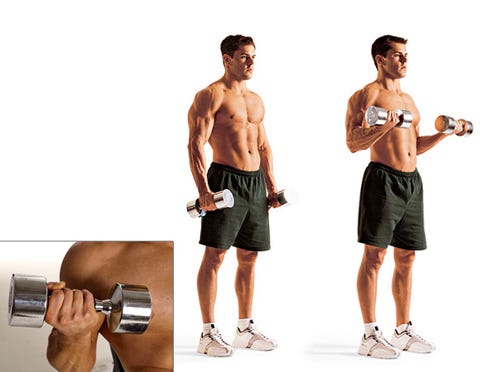
It’s nearly identical to the standard-grip biceps curl, with one important twist: Your palm is not centered on the bar of the dumbbell.
Holding the dumbbell close to one of the heads shifts the weight distribution. It challenges your biceps brachii to work harder to keep your palms facing forward at all points of the exercise.
How to do it: Grab a pair of dumbbells and let them hang at arm’s length next to your sides—either your thumbs or pinkies should rest right next to one of the heads of your dumbbells. Without moving your upper arms, bend your elbows and curl the dumbbells as close to your shoulders as you can. Pause, then slowly lower the weight back to the starting position. Each time you return to the starting position, completely straighten your arms.
Photographs by Beth Bischoff
5. HAMMER CURL

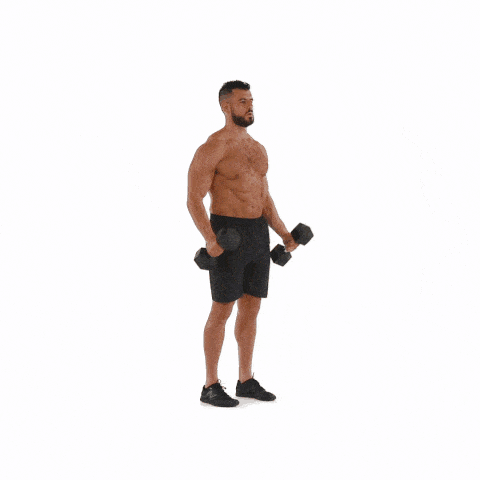
Men's Health
Take your standard-grip curl and flip it on its side. This small difference in the way you hold the dumbbell helps transfer more of the work from your biceps brachii to your brachialis — a muscle that can make your arms look thicker.
How to do it: Grab a pair of dumbbells and let them hang at arm’s length next to your sides with your palms facing your thighs. Without moving your upper arms, bend your elbows and curl the dumbbells as close to your shoulders as you can. Pause, then slowly lower the weight back to the starting position. Each time you return to the starting position, completely straighten your arms.
Photographs by Beth Bischoff
6. STATIC DUMBBELL CURL
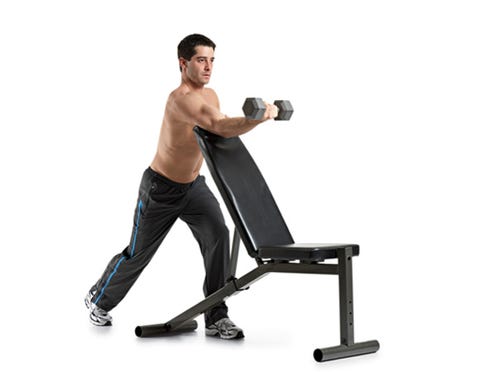
This biceps exercise takes advantage of isometric training, a technique in which you hold the weight in one position for a period of time. It will stimulate your muscles in a way that is different from performing full reps, according to BJ Gaddour, former Men’s Health Fitness Director. And that simple change can spur new growth.
How to do it: Grab a dumbbell with your right hand and stand behind a bench raised to a 45-degree angle. Lower the dumbbell until it’s just beyond half way. Hold for 20 seconds and then repeat on your left arm.
Photograph by Beth Bischoff
7. DECLINE DUMBBELL CURL

Lying chest-down on a bench really isolates the biceps since you don’t have to maintain as much tension in your legs and core muscles as you do when you stand. Use various grips in this position to zero in on different parts of your biceps.
How to do it: Grab a pair of dumbbells and lie with your chest against a bench that’s set to a 45-degree incline. Without moving your upper arms, bend your elbows and curl the dumbbells as close to your shoulders as you can. Pause, then slowly lower the weight back to the starting position. Each time you return to the starting position, completely straighten your arms.
Photographs by Beth Bischoff
8. INCLINE DUMBBELL CURL
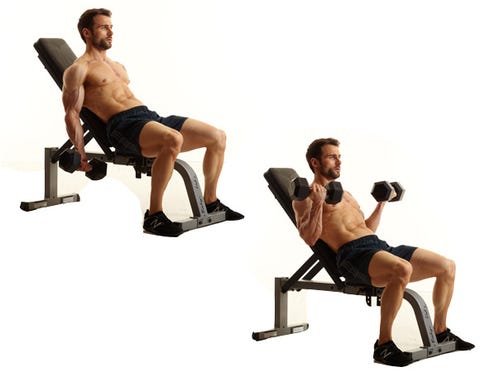
The opposite of the decline variation, you’ll lie on your back, allowing your arms to drop down behind your body. This puts an extra challenge on the long head of your biceps brachii because you’re working from a deficit — meaning, you’re starting the movement at a point where you have less leverage than normal.
How to do it: Grab a pair of dumbbells and lie with your back against a bench that’s set to a 45-degree incline. Without moving your upper arms, bend your elbows and curl the dumbbells as close to your shoulders as you can. Pause, then slowly lower the weight back to the starting position. Each time you return to the starting position, completely straighten your arms.
Photographs by Beth Bischoff
9. KNEELING SINGLE-ARM CURL
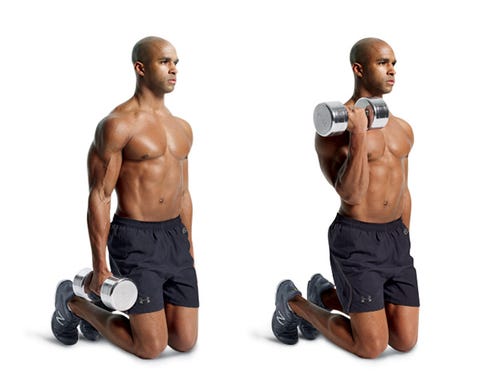
Curling a weight with one arm helps you zero in on weak spots—especially if you have one side that’s stronger than the other, says Gaddour. And performing the biceps exercise in a kneeling position will diminish the chance that you use body English to heave the weight up to the top position.
How to do it: Grab a pair of dumbbells. Hold one dumbbell by your side in your left hand, palm facing your thigh. In your right hand, hold the dumbbell with your palm facing outward. Without moving your upper arm, bend your elbow and curl the dumbbell as close to your shoulder as you can. Pause, then slowly lower the weight back to the starting position. Each time you return to the starting position, completely straighten your arm. Perform all reps on your right arm before switching to your left.
Photographs by Beth Bischoff
10. ZOTTMAN CURL
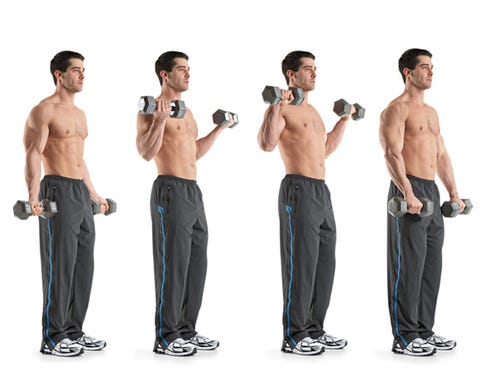
This exercise targets the three major muscles that make up the biceps—the biceps brachii, brachialis, and brachioradialis—by rotating from an underhand to an overhand grip halfway through the move.
How to do it: Grab a pair of dumbbells and let them hang at arm’s length next to your sides. Turn your arms so your palms face forward. Without moving your upper arms, bend your elbows and curl the dumbbells as close to your shoulders as you can. Pause, then rotate the dumbbells so your palms face forward again. Slowly lower the weights down in that position. Rotate the dumbbells back to the starting position and repeat.
Photographs by Beth Bischoff
11. CABLE ROPE HAMMER CURL

Just like the dumbbell hammer curl, this biceps exercise will hit your brachialis to build thickness in your arms. But unlike the dumbbell version, the cable machine keeps a more steady and constant load on the biceps for longer, which may elicit more growth, according to Brad Schoenfeld, Ph.D.
How to do it: Hold both ends of a rope attached to the low pulley of a cable machine. Press your elbows into your sides with your palms facing each other. Keep your feet shoulder-width apart, your torso upright, and your knees slightly bent. Keeping your arms stable throughout the move, curl, the rope toward your shoulders, Pause, and reverse the movement to return to the starting position.
Photographs by Beth Bischoff
12. CABLE ALTERNATING FLEX CURL
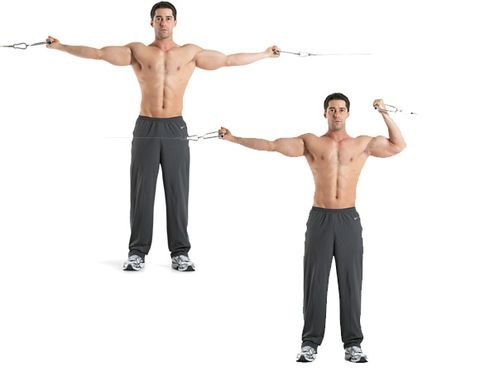
Instead of holding your arms by your sides for this variation of the biceps curl, you’ll keep them extended outwards, parallel to the floor. Just holding your arms in this position will put them to work. Adding a curl helps zero in directly on your biceps.
How to do it: Stand between the weight stacks of a cable crossover station and grab a high-pulley handle in each hand. Hold your arms out to the sides so they’re parallel to the floor. Without moving your right arm, curl your left hand toward your head. Slowly allow your left arm to straight and then repeat the move with your right arm.
Photographs by Beth Bischoff
13. EZ-BAR PREACHER CURL
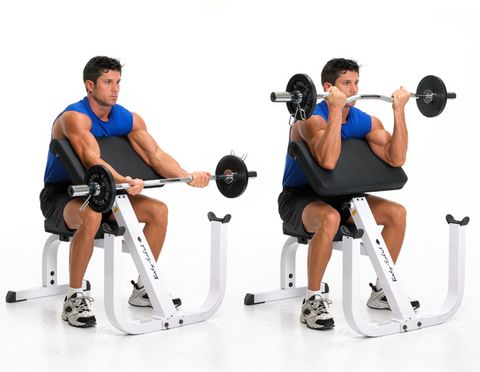
Resting your arms on a sloping pad of a preacher bench helps isolate your biceps by taking your other upper-body muscles out of the equation—meaning, they won’t come into play to assist where your biceps are weakest. If you don’t have the appropriate workstation, you can use a Swiss ball or a bench angled to 45 degrees.
How to do it: Grab an EZ-bar with your hands six inches apart. Rest your upper arms on the sloping pad of a preacher bench and hold the bar in front of you with your elbows slightly bent. Without moving your upper arms, bend your elbows and curl the bar toward your shoulders. Pause, then slowly lower the weight back to the starting position.
14. CHINUP
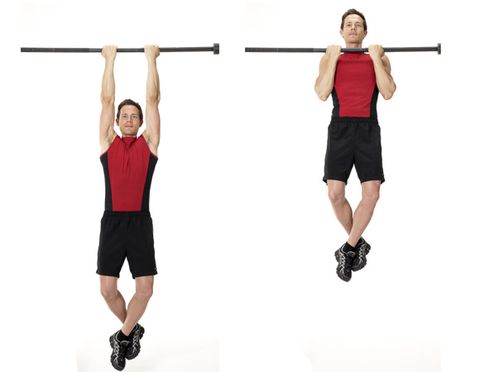
While the chinup doesn’t isolate your biceps, it certainly trains them hard. Along with other muscles in your arms, shoulders, and back, you’ll use your biceps to pull your entire bodyweight from a dead hang, building serious upper-body strength, according to Tony Gentilcore, C.S.C.S., co-owner of Cressey Performance in Hudson, Massachusetts.
How to do it: Grab a chinup bar using a shoulder-width underhand grip and hang at arm’s length. Squeeze your shoulder blades down and back, bend your elbows, and pull the top of your chest to the bar. Pause, and slowly lower your body back to the starting position.
Photographs by Mitch Mandel
15. NEGATIVE CHINUP
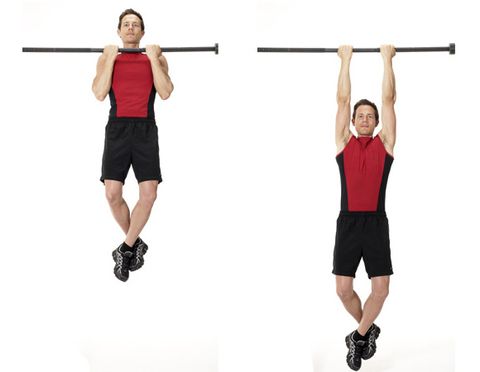
This is especially useful if you—like many men—can’t crank out rep after rep of the full chinup. Since your muscles can handle more weight lowering an object than they can lifting it, you can perform more muscle-building reps of the lowering—or negative—portion of the exercise. The bonus: Lowering actually causes more muscle damage than lifting, which leads to larger guns and bigger biceps.
How to do it: Stand under a chinup bar on a box or bench. Jump up and grab the bar so your chest is even with your hands. Slowly lower your body over the course of 3 to 5 seconds by extending your elbows until your feet reach the box or bench. Pause and repeat.
Photographs by Mitch Mandel
16. START-AND-STOP CHINUP

If you can crank out rep after rep of the chinup and want a bigger challenge, add an isometric hold to the middle of each rep. Doing so will diminish your momentum, according to Gaddour. And since it’s harder to start from a dead stop than it is to keep going, each rep will be harder even though you didn’t add any weight, he said.
How to do it: Perform a chinup and then slowly lower halfway down so your arms are at a 90-degree angle. Pause for a second or two before pulling your chest to the bar again. Pause, now lower all the way down so your arms are straight.
Photographs by Beth Bischoff
17. SEATED CABLE ROW
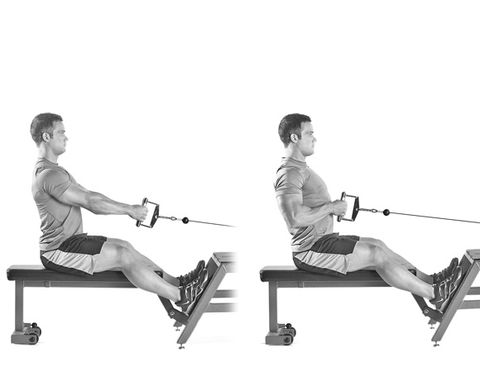
When you sit and row instead of stand and row, your biceps are in the direct line of the pull so they work extra hard during each rep, according to Gentilcore. The seated cable row will also help you build a massive back to compliment your guns.
How to do it: Sit at a seated cable row station with your feet on the platform and your knees slightly bent. Grasp a V-bar with your palms facing each other. Keep your back flat and pull your shoulders back as you pull the bar toward your torso.
Photographs by Thomas MacDonald
18. BENT-OVER BARBELL ROW
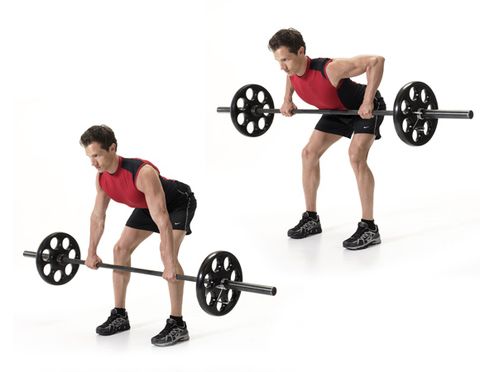
The muscles in your upper body have two functions: push and pull. Your biceps are most active when you pull, according to Alwyn Cosgrove, a Men’s Health Fitness Advisor. Since you’re using other muscles to perform the row, you’ll likely use a weight that’s much heavier than one you would curl.
How to do it: Grab a barbell with your hands just beyond shoulder-width apart and hold it at arm’s length. Bend at your hips and knees, bracing your abs as if you’re about to be punched in the gut. Pull the bar to your ribcage, pause, and then lower back to the starting position.
Photographs by Mitch Mandel
19. PUSHUP-POSITION HAMMER CURL
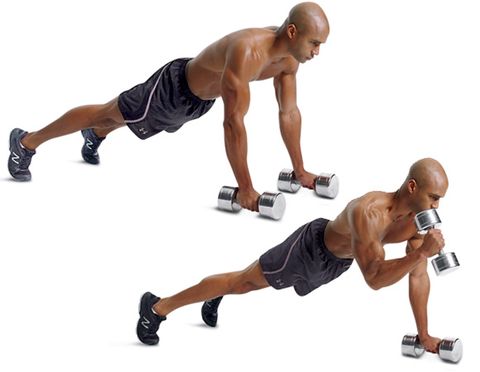
While the hammer curl hits your biceps, the instability of lifting a limb off of the floor while holding a plank will make this an ab burner, too, says Gaddour.
How to do it: Grab a pair of dumbbells and assume a pushup position with your palms facing each other. Without moving your upper arm, curl the weight in your right hand toward your right shoulder. Lower it and repeat with your left arm. Alternate arms with each rep for 30 to 60 seconds.
Photographs by Beth Bischoff
20. SPLIT-JACK CURL
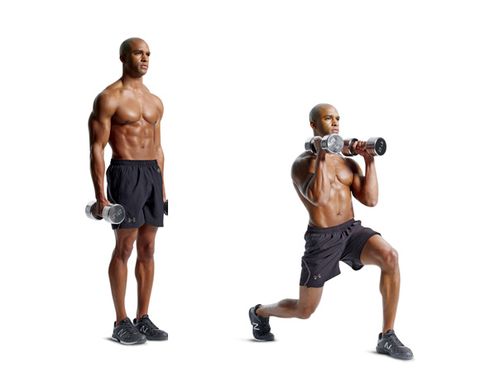
Performing a split jack will assist your biceps in lifting the weights. But because your feet are split instead of parallel to each other, you’re not as stable. You’ll need your arms to work overtime to keep the dumbbells tight to your body in order to keep them from pulling you to the side. The bonus: You’ll jack up your heart rate, as well.
How to do it: Grab a pair of heavy dumbbells and hold them by your sides with your palms facing your thighs. Jump into a split stance and curl the weights to your shoulders at the same time. Pause, and then reverse the movement to return to the starting position. Alternate legs with each rep for 20 seconds.
Photographs by Beth Bischoff
21. RESISTANCE-BAND JUMPING-JACK HAMMER CURL
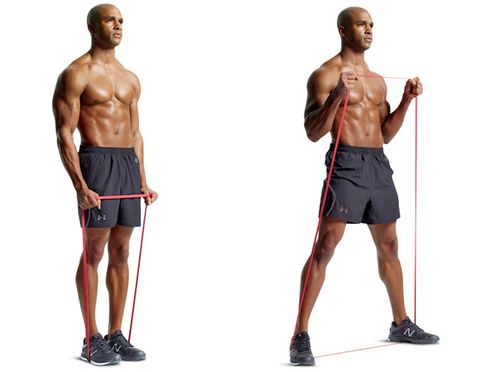
A continuous-loop resistance band might not look as intimidating as iron, but it will pack a punch to your biceps. Jumping your feet out will help to shorten the band, increasing the resistance when you pull up for the biceps curl, explains Gaddour. Additionally, the fast-paced nature of this move will help hammer your muscles in a way you don’t get with slow and steady curls.
How to do it: Stand with your feet together and centered on a continuous-loop resistance band. Hold the top of the band with your palms facing each other. Jump your feet out and curl the band toward your shoulders, simultaneously. Without pausing, reverse the movement to return to the starting position. Perform continuous reps for 20 seconds.
Photographs by Beth Bischoff
22. SQUAT CONCENTRATION CURL
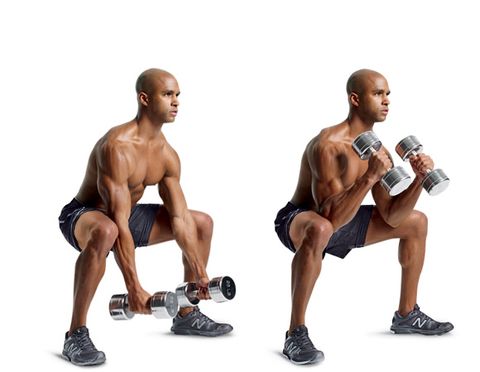
This move will hammer your biceps while you work the larger, energy-hungry muscles of your lower body. It will help you burn calories to reveal your chiseled arms.
How to do it: Grab a pair of light dumbbells and stand with your feet shoulder-width apart. Push your hips back and squat until your thighs are parallel to the floor. Keeping your weight on your heels, your elbows pressed against your inner thighs, and your palms facing each other, curl and lower the weights for 30 to 60 seconds.
Photographs by Beth Bischoff
23. RACKED FARMER’S CARRY
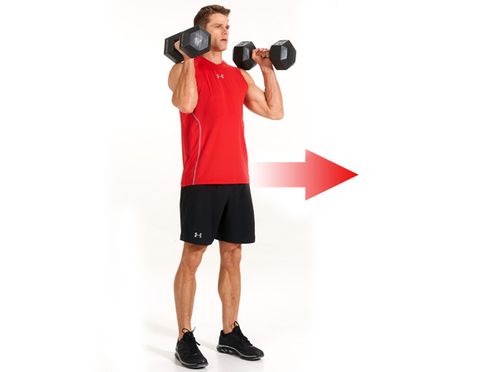
The farmer’s carry is a great way to work your body from head to toe as you walk, but holding the weights in a racked position can help you zero in on your biceps. It’s like an isometric hold for your guns, jostling the weight with every step. And since you typically use extra-heavy weight for farmer’s carries, you’ll overload your biceps in a completely contracted position.
How to do it: Grab a pair of dumbbells and hold them in the racked position so one head of each dumbbell rests by your shoulders. Walk forward for 10 yards, turn around and walk back.
Photograph by Mitch Mandel
24. DUMBBELL CLEAN
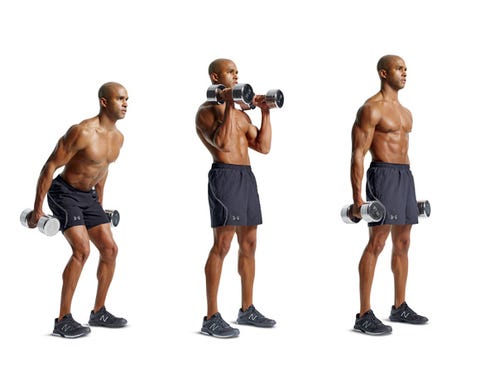
Muscles grow through a combination of load and time under tension. By starting each rep with the weights at your sides and then lifting them to your shoulders, you effectively double the amount of time your biceps spend working.
How to do it: Hold a pair of dumbbells at arm’s length, your palms facing each other. Bend your hips and knees so that the dumbbells hang at knee level. In one move, explosively pull the dumbbells upward as you thrust your hips forward; then “catch” the dumbbells at shoulder height. Stand tall, and then return to the starting position. Make sure to use a manageable weight: 35- to 50-pound dumbbells are about right for most guys.
Photographs by Beth Bischoff
25. UNDERHAND-GRIP INVERTED ROW
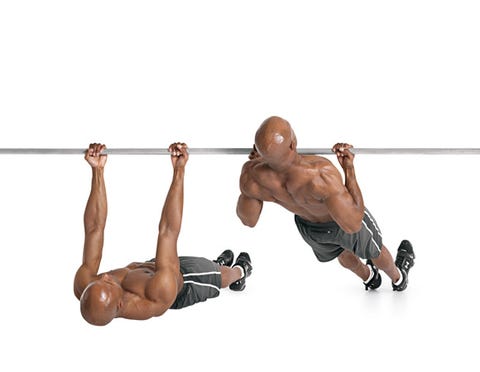
The inverted row is primarily an upper-back exercise. However, using an underhand grip instead of a standard grip forces your biceps to work harder.
How to do it: Grab a bar with an underhand, shoulder-width grip. You palms should be facing you. Hang with your arms completely straight. Your body should form a straight line from your ankles to your head. Initiate the movement by pulling your shoulder blades back, then continue the pull with your arms to lift your chest to the bar. Pause, then slowly lower your body back to the starting position.
Photographs by Beth Bischoff
Source: Read Full Article
